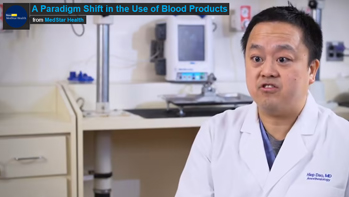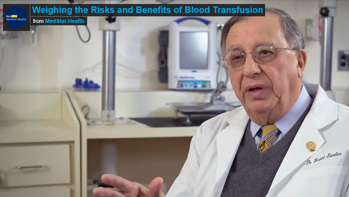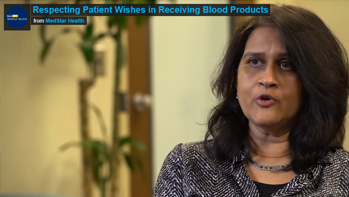Bloodless strategies
The human body tolerates anemia even when hemoglobin is profoundly reduced.
Tolerating low hemoglobin
Fundamental physiological processes relevant to all types of anemia — the compensatory mechanisms that are triggered in the anemic patient.
By Stephen Selinger, MD
MedStar Franklin Square Medical Center
Meticulous surgery
To avoid blood loss, meticulous and precise surgical technique remains the most important. By carefully following this total management approach and carefully adhering to sound surgical principles and techniques as suggested here, redo-cardiac surgery can be performed safely and successfully without blood transfusion.
By Manuel R. Estioko, M.D.
Hyperbaric oxygen therapy
Hyperbaric oxygen (HBO) therapy is a medical treatment in which patients inhale 100% oxygen in a total body chamber, under increased but controlled pressures. It is used for a wide variety of treatments, usually as a part of an overall medical care plan.
By Dr. Kelly Johnson-Arbor
IV iron dextran infusion protocol
The following is the methodology I use for the administration of intravenous iron dextran, for total dose infusion. I have used this method for more than thirty-five years and it has worked quite well, with uniformly safe outcomes.
By William Pogue, M.D.
Bloodless fundamentals – CE accredited
Fundamentals
History of bloodless medicine and surgery
This introductory module walks learners through the history of bloodless medicine and surgery and identifies key factors that led to the growth of the bloodless approach.
Fundamentals
Bloodless medicine and surgery strategies
This module discusses the primary pillars of bloodless medicine and surgery and outlines strategies that ensure patient safety and well-being.
Fundamentals
Legal and ethical considerations of bloodless medicine and surgery
This module discusses the legal and ethical considerations around the bloodless approach and identifies strategies that promote shared decision-making between healthcare providers and their patients.
Clinical pearls
“I think it’s becoming mainstream; it certainly should be.”
Willard Barnes, MD
Georgetown Lombardi Comprehensive Cancer Center
Contributed reports

“We believe that these general guidelines can be used in many patients for optimization starting in the antenatal period…”
Sepideh Khalilian, MD
Georgetown University Hospital
-
Abstract
Bloodless surgery was introduced initially for the care of patients who refused blood transfusion. Recently however, adverse outcome with blood transfusion has been reported in virtually all subspecialties of surgery and conversely, improved outcome with non-transfusion surgery. Thus blood conservation is the standard of care because it is evidence-based. Thyroid surgery is historically associated with blood loss, and a lower hemato- crit would be expected postoperatively. We report a case of subtotal thyroidectomy for a large simple multinodular goiter using planned blood-conservation techniques tailored to the patient that resulted in maintenance of a normal hematocrit throughout the perioperative period. The patient received oral hematinics preoperatively, while acute normo- volemic hemodilution and other techniques were used to minimize intraoperative blood loss. The outcome was an optimized hematocrit preoperatively, minimal blood loss intraoperatively, and hematocrit which remained optimal on the third postoperative day and 3 weeks postoperatively. No allogeneic blood was used at any stage. This suggests that maintenance of normal hematocrit can be regarded as an achievable goal in high-risk surgery through blood-conservation techniques. Avoid- ing allogeneic blood transfusion is possible in a resource-poor setting, where HIV prevalence is high and screening of blood may be suboptimal, and it is the ideal clinical approach as demonstrated in this case report.
By Nathaniel Usoro, MD
-
Abstract
The management of Jehovah’s Witness patients with bleeding and severe anemia can be very challenging because of non-acceptance of allogeneic blood transfusions. The challenge to the healthcare provider becomes even greater when the anemia becomes life-threatening in the presence of other co-morbid conditions.
A 32-year old primigravida in her 38-39 week of gestation, in labor, presented to the ED of our hospital on March 4, 2016, as referred by her obstetrician in another institution, for anemia, not responding to oral and IV iron. She complained of dizziness and hunger pangs and disclosed to the admitting obstetrician (OB) that her former OB advised her to reduce her food intake to avoid having a big baby and undergoing a cesarean delivery. She regularly took oral iron (105 elemental iron) once daily starting on her 3rd month of gestation. However, her haemoglobin , taken on 3 occasions (10 days, 3 days, and a day) prior to her admission stayed between 9.2-9.7 g/dL. She was given IV iron sucrose 3 times (dose not specified) a couple of weeks prior to this admission.
Physical examination at the ED showed an ambulatory, asthenic, pale pregnant patient with BP=120/80, HR=85/min, T=36.6 C, weight = 42.5 kg (93.5 lbs), height = 5’1” , without signs of obvious bleeding or icteresia . Haemoglobin and hematocrit taken at the ED were 11.5 g/dL and 0.34, respectively. The haematologist made a peripheral smear which showed normocytic , normochromic red cells with a few microcytic ones, no immature white blood cells, and a slight thrombocytosis. ECG was normal. Urinalysis showed infection. Pre-eclampsia (BP = 130/90 – 160/100) and azotemia complicated her pregnancy. ( Table 1). Prothrombin time and aPTT , ALT, serum Na, K, Cl, TSH and FT4 were normal, FT3 low.
On the 4th hospital day (HD 4), she underwent vacuum-assisted delivery to a 2.3-kg baby , and sustained haemorrhage from lacerations in the vaginal wall and cervix. Management included tranexamic acid 1 gram every 8 hours for 6 doses, 6% HES 130/0.4 (Voluven) for blood replacement, and crystalloids. When Hb dropped to an alarming 3.4 g/dL, she was tachycardic and had shortness of breath. O2 inhalation and Ivabradine 5 mg BID was given for tachycardia. At this time, vaginal bleeding was minimal. The haematologist and nephrologist tried convincing the patient and family to receive blood transfusion. Then, I joined the medical team caring for her, per family’s request.
Anemia management included iron sucrose 200 mg and EPO 4,000 units given on admission and post-delivery every other day for 5 doses; EPO 4,000 units (2 doses) a day apart and subsequently 10,000 units every other day for 4 doses, IV Vitamin B12, oral folic acid, O2 , regular diet and complete bed rest. Phlebotomy was minimised to necessary tests only. No RBC was given.
Ascites, pleural effusion and severe peripheral edema and a very low serum albumin were noted. Diuresis was done. Ultrasound showed liver and renal (Grade 1) parenchymal disease. The patient accepted albumin after consultation with her family. On HD 12 (postpartum day 8), Hb rose to 6.0 g/dL, and upon discharge on the 18th HD, it was already 9.0 g/dL. On the same day, serum albumin was minimally improved.
This Jehovah’s Witness patient with postpartum life-threatening anaemia complicated by severe undernutrition, pre-eclampsia, chronic kidney disease, severe leukocytosis and thrombocytosis was successfully treated with non-blood management and has had monthly follow-up with her obstetrician and nephrologist.
Table 1
Test ED HD3 HD4 HD5 HD6 HD7 HD12 HD18 Assisted
DeliveryHb (g/dL) 11.5 9.0 3.4-4.8 < 4.8 3.6 6.0 9.0 Hct 0.34 0.26 0.11-0.14 0.12 0.11 0.16 0.26 WBC 11.47 12 19.5- 25.4 28.91 35.59 16.52 13.74 Platelets 331 324 328-153 144 184 312 643 Creatinine (umol/dL)
(NV: 5.3-8.84)17.1 18.0 22.38 16.41 13.98 BUN (mmol/dL)
(NV: 2.5-6.4)0.698 0.51 1.447 Albumin
(NV: 3.5-5.2 g/dL)1.61 2.4 2.6 By Angelina A.Gapay, MD
-
Abstract
In primary or first time cardiac surgery, it takes just several minutes for the surgeon to open the chest by median sternotomy (cutting the breast bone). The anatomic landmarks are intact, which allows the surgeon to perform the heart operation without a lot of difficulty. In fact, many operations have been performed without blood transfusion. Some patients later require a repeat operation—redo-surgery, for example redo-valve replacement or redo-coronary artery bypass graft (CABG). Redo-surgery presents added challenges. Adhesions or scars develop as a natural consequence of the body healing, and the heart is often encased by scars and attached intimately to surrounding vital structures. Repeat median sternotomy is the usual access to the heart. This procedure has to be done very carefully because the heart is just underneath the sternum. Opening the chest may take 30 minutes to an hour or more, depending on the severity of adhesions. Careful dissection is continued to free the heart before proceeding with the planned operation, which adds to the operative time. Therefore, redo-operation is a much more involved operation, with higher risk of potential bleeding and complications.
Is it possible to do redo-cardiac surgery without blood transfusion? This report of a single-surgeon experience is important, since there are no large-series reports on this subject specifically involving Jehovah’s Witness patients, who for religious reasons absolutely do not accept blood transfusion.
Clinical Report
Forty-two (42) adult Jehovah’s Witness patients were reoperated. All the previous heart surgeries were by median sternotomy. There were twenty-eight (28) male and fifteen (15) female patients. The age range was thirty-three (33) to seventy-six (76) years. Thirty-one (31) of the cases were valve operations: twenty-three (23) single valve replacements and eight multiple valves. Of the multiple valves, five (5) were double valves—mitral valve replacements (MVR) and aortic valve replacements (AVR) and three were triple valves—MVR and AVR and tricuspid valve repairs (TVr). There were ten (10) redo-CABG. Six (6) patients had third-time operations. One of these had resection of the ascending aorta and Dacron graft repair for increasing size aneurysm, six cm in transverse diameter. This patient had the first aortic valve repair as a youngster because of a stenotic valve, followed years later with AVR. These operations are summarized in the following table:
Redo-Cardiac Surgery
(n = 42)
Redo Cardiac Surgery (n=42) Valve replacements 23 Mitral=11 Aortic=11
Tricuspid= 1
Double Valve 5 Triple valve (MVR, AVR, TVr)
3 Redo CABG 10 Asc. aorta aneurysm repair 1 Results:
All the redo-surgery patients survived their operations except one. The 30-day mortality rate is 2.3%. The patient who did not make it expired 22 days after surgery because of complication of CVA (cerebro-vascular accident) unrelated to blood loss or anemia. There was no significant bleeding encountered in the entire series.
About the Author
Manuel R. Estioko, MD is a Cardiac Surgeon from Los Angeles, California. He first developed an interest and involvement in Bloodless Surgery because of the very high incidence of Hepatitis C in open heart patients (18 % in New York City). At that time (late 1960’s & 1970):
- Almost all patients received blood transfusion, the early heart/lung machines required high volume prime with use of blood.
- Blood was obtained from donors with questionable health through commercial blood banking, (the change to all volunteer donors came years later).
- There was no blood test for Hepatitis.
In 1996, Dr. Estioko coined and popularized the term “Transfusion Free Surgery” which is the other widely used designation for Bloodless Surgery.
By Manuel Estioko, MD
Share your experience
We offer you the opportunity to help improve care for Jehovah’s Witnesses around the world by sharing your experience. We will be glad to receive your previously published or unpublished case report or article focused on the strategies of bloodless care.
Additional information
We offer free consulting services for administrators and physician leaders wishing to establish a bloodless medicine and surgery program.
Interested in starting a bloodless program?
Learn how you can implement a bloodless program in your institution.












